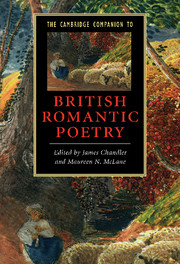Book contents
- Frontmatter
- Introduction: The companionable forms of Romantic poetry
- 1 The living pantheon of poets in 1820: pantheon or canon?
- 2 Romantic poetry and antiquity
- 3 Romantic meter and form
- 4 Romantic poetry and the standardization of English
- 5 Thinking in verse
- 6 Romantic poetry and the romantic novel
- 7 Wordsworth’s great Ode: Romanticism and the progress of poetry
- 8 Romantic poetry, sexuality, gender
- 9 Poetry, peripheries and empire
- 10 Romantic poetry and the science of nostalgia
- 11 Rethinking Romantic poetry and history: lyric resistance, lyric seduction
- 12 The medium of Romantic poetry
- 13 Romantic poets and contemporary poetry
- Index
- Series List
13 - Romantic poets and contemporary poetry
Published online by Cambridge University Press: 28 November 2008
- Frontmatter
- Introduction: The companionable forms of Romantic poetry
- 1 The living pantheon of poets in 1820: pantheon or canon?
- 2 Romantic poetry and antiquity
- 3 Romantic meter and form
- 4 Romantic poetry and the standardization of English
- 5 Thinking in verse
- 6 Romantic poetry and the romantic novel
- 7 Wordsworth’s great Ode: Romanticism and the progress of poetry
- 8 Romantic poetry, sexuality, gender
- 9 Poetry, peripheries and empire
- 10 Romantic poetry and the science of nostalgia
- 11 Rethinking Romantic poetry and history: lyric resistance, lyric seduction
- 12 The medium of Romantic poetry
- 13 Romantic poets and contemporary poetry
- Index
- Series List
Summary
The Romantics among the English poets
John Keats's assertion in a letter that he would be “among the English Poets” after his death is usually understood to be a proudly defensive declaration, against attacks on his poetry in the Quarterly Review and elsewhere, that once he was dead his genius would be properly recognized and his work would become a prominent part of the canon of English Literature. “This is a mere matter of the moment,” Keats declares of his detractors' aspersions: “I think I shall be among the English Poets after my death.” One might think of Keats's sense that he will be properly recognized only after death as no more than an acknowledgment of the idea that, as Samuel Johnson put it in his 1765 “Preface to Shakespeare,” a century is “the term commonly fixed as the test of literary merit”: Keats would be recognized after his death for the simple reason that he could not be recognized before it. And some critics have argued that his comment specifically alludes to a relatively new kind of publishing venture: canon-forming, and nation-building multi-volume collections of poems by the English (or British) poets such as the 44-volume edition of The British Poets overseen by Hugh Blair (1773-6), The Works of the English Poets, with Prefaces, Biographical and Critical, by Samuel Johnson (68 volumes, 1779-81); John Bell's 109-volume The Poets of Great Britain (1777-83); and Alexander Chalmers's 21-volume The Works of the English Poets (1810). According to this reading, Keats was imagining that after his death his poems would literally take their place within the covers of such volumes alongside, or “among,” those of his beloved Shakespeare, Spenser, and Milton. But we might also understand Keats to be proposing something rather different - something that is nevertheless consequential upon the desire for his poems to be bound together with those of Shakespeare.
- Type
- Chapter
- Information
- The Cambridge Companion to British Romantic Poetry , pp. 263 - 278Publisher: Cambridge University PressPrint publication year: 2008
- 1
- Cited by



